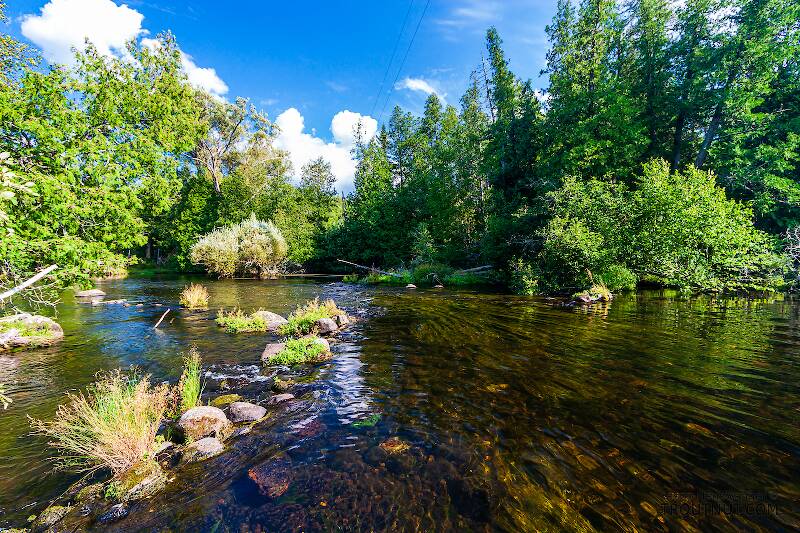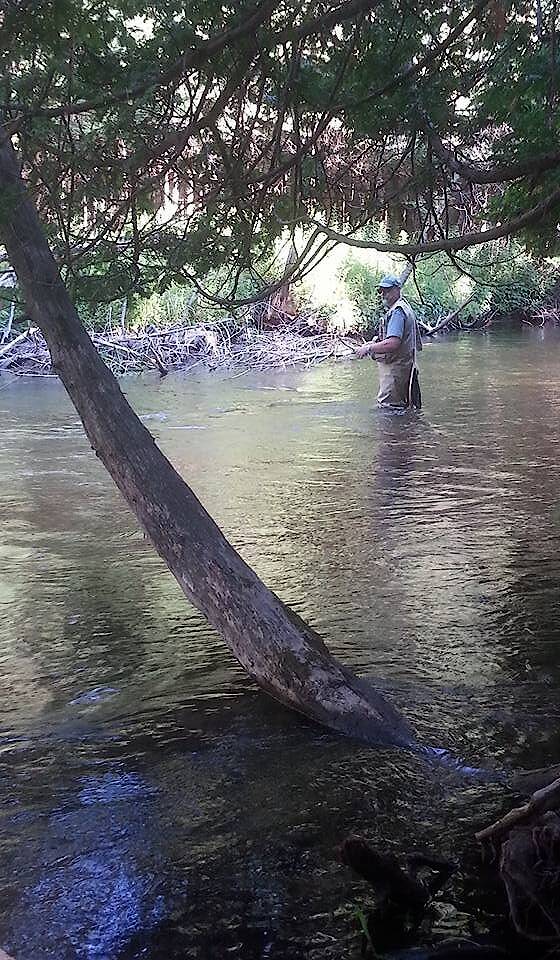
Blue-winged Olives
Baetis
Tiny Baetis mayflies are perhaps the most commonly encountered and imitated by anglers on all American trout streams due to their great abundance, widespread distribution, and trout-friendly emergence habits.
Featured on the forum

I was not fishing, but happened to be at an unrelated social event on a hill above this tiny creek (which I never even saw) when this stonefly flew by me. I assume it came from there. Some key characteristics are tricky to follow, but process of elimination ultimately led me to Sweltsa borealis. It is reassuringly similar to this specimen posted by Bob Newell years ago. It is also so strikingly similar to this nymph from the same river system that I'm comfortable identifying that nymph from this adult. I was especially pleased with the closeup photo of four mites parasitizing this one.

Troutnut is a project started in 2003 by salmonid ecologist Jason "Troutnut" Neuswanger to help anglers and
fly tyers unabashedly embrace the entomological side of the sport. Learn more about Troutnut or
support the project for an enhanced experience here.
Roguerat on May 16, 2020May 16th, 2020, 1:42 am EDT
Kind of an esoteric question, but I'm wondering about favorite or effective Caddis emerger patterns here. Any experience or opinions on LaFontaine sparkle pupa vs. Iris Caddis flies? I've got minimal experience with either but I'm tying today (between downpours, the local streams are at 3-4X normal/wadeable flows) and venturing into new territory of Caddis patterns.
tight lines,
Roguerat
"Less is more...'
Ludwig Mies Vande Rohe
tight lines,
Roguerat
"Less is more...'
Ludwig Mies Vande Rohe
Wbranch on May 16, 2020May 16th, 2020, 12:31 pm EDT
I have fished both and prefer the LaFontaine emergent pupa with the trailing shuck over the Iris caddis. I like the 180 degree bubble on top. I tie it in only rust or green body. I always use tan yarn for the shuck and bubble and coastal brown deer hair sparse for the wing.
Catskill fly fisher for fifty-five years.
BoulderWork
Posts: 29
Posts: 29
BoulderWork on May 18, 2020May 18th, 2020, 1:43 am EDT
Roguerat,
Wbranch and I have the same beliefs. I am a big advocate of Gary LaFontaine patterns. The combination of Gary LaFontaine's Caddisflies and Thomas Ames Caddisflies publications fill my on-going pursuit. A very key consideration for duplication of the LaFontaine sparkle series is to utilize the correct Sparkle Yarn materials.
Wbranch and I have the same beliefs. I am a big advocate of Gary LaFontaine patterns. The combination of Gary LaFontaine's Caddisflies and Thomas Ames Caddisflies publications fill my on-going pursuit. A very key consideration for duplication of the LaFontaine sparkle series is to utilize the correct Sparkle Yarn materials.
Wbranch on May 18, 2020May 18th, 2020, 11:01 am EDT
Boulderwork wrote;
That is a very good point while I have never adhered to Mr. LaFontaine's "Touch Dub" technique to apply dubbing to create the body. I use very fine Antron that I purchased years ago in a ten color dispenser. I make a dubbing loop and insert chopped up strands of the Antron into the dubbing loop. But the yarn I use for the bubble has great translucency and sparkle. It is three strand yarn and depending on the hook size I use one or two strands of yarn for the covert/bubble. I separate the fibers with my bodkin. A few fibers become the trailing shuck.
A very key consideration for duplication of the LaFontaine sparkle series is to utilize the correct Sparkle Yarn materials.
That is a very good point while I have never adhered to Mr. LaFontaine's "Touch Dub" technique to apply dubbing to create the body. I use very fine Antron that I purchased years ago in a ten color dispenser. I make a dubbing loop and insert chopped up strands of the Antron into the dubbing loop. But the yarn I use for the bubble has great translucency and sparkle. It is three strand yarn and depending on the hook size I use one or two strands of yarn for the covert/bubble. I separate the fibers with my bodkin. A few fibers become the trailing shuck.
Catskill fly fisher for fifty-five years.
Quick Reply
Related Discussions
Topic
Replies
Last Reply
1
Jan 10, 2012
by Doublespey
by Doublespey
40
Nov 23, 2015
by Martinlf
by Martinlf
28
Nov 24, 2015
by Martinlf
by Martinlf



